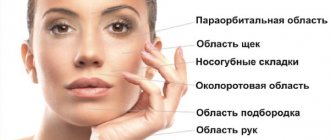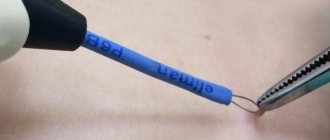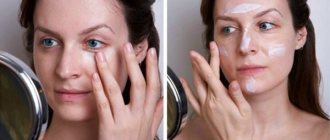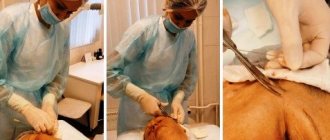Author
Frolov Konstantin Borisovich
Doctor
Candidate of Medical Sciences
Phlebologist
until January 31
You get 10% cashback when purchasing a gift certificate More details All promotions
The essence of the method is that a special substance, a sclerosant, is injected into a capillary or vein that has undergone varicose changes. The vessel is then compressed using a latex pad or elastic bandage, causing the walls of the vessel to stick together and the pathological vessel is excluded from the bloodstream. The glued walls of the vessel quickly grow together, leaving behind a subcutaneous scar, which soon resolves without leaving any traces.
Before sclerotherapy
- be sure to tell your doctor if you are taking hormonal medications (contraceptives, estrogens, etc.);
- stop taking aspirin, trental, ibuprofen and other anti-inflammatory drugs 2 days before treatment. These medications may increase tissue bleeding and increase the risk of bruising;
- you should not drink alcohol or smoke for 2 days before and after sclerotherapy;
- on the eve of sclerotherapy, you should not perform hair removal, use lotions, creams;
- take a hygienic shower, wash your feet with regular or antibacterial soap;
- Come to treatment in comfortable, loose clothing and shoes;
- It is advisable to eat lightly 1.5 hours before sclerotherapy. Sclerotherapy is a painless treatment procedure. To perform this, special thin needles or microcatheters are used (thin tubes with needles thinner than a human hair).
Modern sclerosants are absolutely safe and have an anesthetic effect, so their administration may be accompanied by only a slight burning sensation. If during treatment you experience any unpleasant sensations (pain, nausea, dizziness, etc.), tell your doctor immediately.
Drugs
Sclerotherapy of varicose veins is performed by administering liquid and foam preparations. At the Yusupov Hospital, doctors use sclerosants for sclerotherapy, registered in the Russian Federation. They are effective and have a minimal range of side effects.
Drugs that are used for sclerotherapy, after being introduced into the lumen of a venous vessel, affect the inner layer of the vein and cause denaturation of the protein of the inner lining. The lumen of the vein collapses, the walls “stick together”, it becomes empty and is replaced by connective tissue.
There are 3 groups of drugs for sclerotherapy:
- Detergents;
- Osmotic solutions;
- Corrosives.
Detergents are surfactants. They are capable of destroying intercellular tissue within a few seconds. The first signs of the effects of osmotic solutions are visible 5 minutes after injection of the drug into the lumen of the vein, and the maximum result is achieved after 30 minutes. The phlebosclerosing effect of the drugs directly depends on the saturation of the solution. Corrosive drugs act simultaneously on the internal and muscular layers of the vein.
The following drugs for vein sclerosis are registered in the Russian Federation: thrombovar, ethoxysklerol, fibro-vein. The main advantage of thrombovar is its availability and attractive price. After administration of the drug, side effects often develop: allergic reactions, pain. For this reason, doctors at the Yusupov Hospital do not use this medicine for sclerotherapy.
Ethoxysclerol has a strong adhesive effect and has a minimal range of side effects. The drug is used for sclerosis of reticular veins, spider veins, small tributaries and perforating veins. Fibro-vein is characterized by high phlebosclerosing activity. It is used for sclerotherapy of large veins. The drug can have significant side effects: skin necrosis and hyperpigmentation.
Advantages and disadvantages of foam sclerotherapy for veins
For Foam-Form sclerotherapy, doctors use fine foam, which is obtained by mixing gas (oxygen, carbon dioxide, air) with a sclerotherapy solution. The foam consists of a large number of gas bubbles, the wall of which is a sclerosing agent. It displaces blood from the vessel, thereby ensuring the effect of an empty vein. The foam, remaining in the lumen of the vein until the bubbles disintegrate, acts on the vessel wall much longer than the sclerosant in its natural form.
The main difference between the action of the foam is the pronounced persistent spasm of the venous vessel, which it fills despite the fact that the initial concentration of the liquid drug used to obtain the foam is low. The diameter of the vein can decrease by 5 times. As a result of spasm of the vein in the vessel, sclerophlebitis develops, rather than classic thrombophlebitis (red blood clot).
Foam-Form sclerotherapy has the following advantages:
- More complete contact of the sclerosant with the venous wall is ensured, due to the absence of blood in the lumen of the vessel;
- The volume of the drug is increased due to gas, which allows you to reduce the dose of its natural form and reduce the cost of the procedure;
- Thanks to the use of a drug of lower concentration, which ensures the effect of scleroobliteration, the risk of complications (skin necrosis and pigmentation) is reduced;
- The duration of contact of the foam solution with the vein wall and the length of the sclerosed zone increases in comparison with classical therapy;
- The phlebologist has the ability to carry out echo control of the process of administering the sclerosing drug and its distribution throughout the venous network.
Some patients, due to individual intolerance or other reasons, extremely rarely develop adverse reactions and complications of foam sclerotherapy. In terms of time of occurrence, they can be early (develop directly during the procedure) and late (appear after several hours or even days), and in terms of severity - mild and severe. Allergic reactions may occur in patients prone to allergies. They manifest themselves as urticaria or mild bronchospasm and go away on their own within 30 minutes.
Nausea, dizziness and fainting, a feeling of lack of air and tightness in the chest are the result of vascular spasm or a psycho-emotional reaction. More common during venous puncture and insertion. Sometimes doctors accidentally inject a sclerosing agent into an artery or nerve. Phlebologists at the Yusupov Hospital are fluent in the technique of foam sclerotherapy and do not allow technical errors when performing the procedure.
An extremely rare complication of foam sclerotherapy is visual disturbances (double objects, flickering “spots” and blurred vision). It occurs when foam bubbles move from the right side of the heart to the left, due to the presence of septal defects (oval window, atrial or ventricular septal defect), and from there into the systemic circulation and into the cerebral vessels. At the Yusupov Hospital, before performing foam sclerotherapy on a patient, doctors conduct a comprehensive examination to exclude concomitant pathologies that increase the risk of complications.
Make an appointment
After sclerotherapy
- at the end of sclerotherapy, a special elastic bandage (medium stretch) is applied to the leg or a compression stocking (functional class 2) is put on, which should be worn around the clock for 1, 2 or 3 days, and daily, removing the bandages or stockings at night - 3 days, 1 or 3 weeks (determined by the doctor);
- you need to walk for 10-30 minutes;
- remember that the drug contains alcohol, so you should not drive after sclerotherapy;
- do not limit physical activity. Walk for at least 1 hour every day; - Avoid standing or sitting for long periods of time;
- do not take hot baths for 2 weeks and do not visit the sauna and bathhouse for 1.5-2 months;
- In the first 3 days after sclerotherapy, you should not engage in aerobics, gymnastics or on an exercise bike.
Remember that sclerotherapy does not always guarantee a lifelong recovery and subsequent treatment may be required. The best way to prevent relapse of the disease is the constant use of special preventive or therapeutic tights.
Results of sclerotherapy for reticular varicose veins after 2 months
After 2 months, the patient came to me for a follow-up examination. The condition of the lower extremities is ideal. Repeated sessions of Foam-form sclerotherapy for reticular veins are no longer required.
Excellent result after 2 sessions of Foam-form sclerotherapy
What side effects might there be?
- Itching of the skin depends on the type of sclerosing agent and usually goes away within 1-2 hours after the procedure. In some cases, it can occur sporadically for a day or more.
- Temporary darkening of the skin along the sclerotic vein is observed in 5-8% of patients. Light brown stripes of skin in some cases can persist for up to 1 year.
- Peeling of the skin is observed in less than 1% of cases. In this case, a small superficial wound is formed at the injection site, which heals without a trace in 2-4 weeks.
- Allergic reactions are very rare. Their risk is highest in patients who are allergic to other types of medications.
- Pain at the injection sites or along the sclerotic vein is noted in a small number of cases. Nagging pain at the injection sites usually occurs during physical activity and can last for 3-9 days.
- In rare cases, 2-4 weeks after treatment, a thin reddish vascular “mesh” may appear along the sclerotic vein, usually disappearing on its own within 4-6 months.
- Short-term swelling in the ankle area can be observed when treating varicose veins and spider veins located in this area, as well as when wearing high-heeled or narrow shoes during treatment.
- Inflammation of the vein - thrombophlebitis - is a rare complication of sclerotherapy, occurring in 1 case per 1000 patients. Thrombophlebitis occurs when you violate doctor’s instructions and remove the elastic bandage yourself.
Developed by the Association of Phlebologists of Russia
Technique for sclerotherapy (scleroobliteration) of veins
The sclerotherapy technique is non-traumatic and does not require hospitalization or changes in the usual rhythm of life, and is well tolerated by patients.
One-handed sclerotherapy technique
The session is performed in a horizontal position. Sometimes it is necessary to create an elevated position of the limb. Injections are performed with the thinnest 27-30G needles, so they are practically not felt by patients. After treating the skin with an antiseptic solution, sclerosant is injected into the lumen of the veins. Depending on the caliber of the vessels and their location, a liquid or foam form of one concentration or another is used. The introduction is carried out slowly to avoid stretching and rupture of the vessel. For additional visualization, ultrasound guidance or a venovisor can be used.
Use of modern methods of vein visualization
After the injections, bandages are applied to the skin along the veins, and class 1 or 2 compression hosiery is worn.
Sclerotherapy is an excellent remedy for varicose veins on the legs!
Sclerotherapy has begun to appear more and more often in Moscow clinics. Indeed, she:
- popular,
- effective,
- safe.
This is an excellent remedy for varicose veins on the legs. This procedure involves the introduction of a specific drug into the diseased vein. If certain conditions are met, this sclerosant practically “seals” the vein. Over time it will disappear completely
This procedure continues for a long time. Sometimes it provides a decent cosmetic effect even for life. You just need to contact one of our phlebolic doctors for help. They will definitely select a course of treatment.
Our competitive advantages and the best remedy for varicose veins on the legs
Sclerotherapy is an excellent investment. With a little patience and courage, you will get excellent legs: slender, light, capable of moving long distances. When you contact a doctor, you need to inform him about all the chronic diseases, infections, and so on that you currently have.
Next, the phlebologist will recommend the best remedy for varicose veins on your legs. He will definitely help you prepare, go through all the examinations, and then return to normal, everyday life. You will definitely receive detailed instructions on how to behave after the operation. With our help, you will definitely return to an active life!
Indications for sclerotherapy (scleroobliteration) of veins
Any varicose vein can be successfully treated with endovenous chemical obliteration. The emergence and availability of modern minimally invasive methods of thermoobliteration (EVLO, RFO) has somewhat narrowed the range of applications of sclerotherapy (scleroobliteration) of veins in Moscow. But it remains still relevant, and sometimes irreplaceable.
Most often the indications are as follows:
- The presence of reticular varicose veins and telangiectasias is often an aesthetic problem; sometimes bleeding from these vessels is indicated.
- Isolated varicose veins of the tributaries of the small or great saphenous veins.
- The presence of pathological reflux in the perforating veins, after its elimination in the main ones.
- If other treatment methods are contraindicated for patients with the stem form of varicose veins. It has been proven that the intervention is effective even when the diameter of the ostial valve of the great saphenous vein is up to 30 mm.
What is sclerotherapy for the veins of the lower extremities?
Modern sclerotherapy of the veins of the lower extremities is a method of treating both spider veins and varicose veins. It is safe and very effective. These factors ensure its popularity.
A special drug called a sclerosant is injected into the diseased vein. If specific conditions are met, he can “seal” the problematic vein. Subsequently, it disappears completely. Usually this procedure gives a very long-lasting decent cosmetic result. In some cases, it is fixed for life.
Sclerotherapy surgery: is it often required?
The course of the sclerotherapy operation usually includes from three to ten injections. Their number is determined in accordance with the type of sclerosing drug, as well as the characteristics of the venous lesion. As a rule, from one to five courses are required, with an average of two to three. It all depends on the specifics of each case.
It is necessary to inform the doctor about the regular use of certain medications, and also get recommendations on lifestyle before and after surgery. Sclerosants are now safe, moreover, they have an anesthetic effect. So the worst thing that awaits you is a slight burning sensation. If you have any other problems, report them to your doctor immediately.
Types of sclerosants for vein sclerosis
Currently, the following groups of drugs are used in the world for the purpose of sclerosis:
- Detergents, which are fatty (carboxylic) acids and fats. These include: sodium morruate, ethanolamine oleate, tetradecyl sulfate, polidocanol, glycerin.
- Hypertonic and ionic solutions: hypertonic sodium chloride solution (20 and 23.4%); sclerodex – a mixture of 25% dextrose; 10% NaCl with a small amount of 2-phenylethanol; ionized iodine (variglobin).
- Cellular toxins.
The most widely used drugs are the detergent group.
Tetradecyl sulfate (Fibro-vane)
Their action is based on the extraction and denaturation of endothelial membrane proteins of the venous wall. This leads to delayed cell death and obliteration of the vein. The detergent only affects the pathologically altered vein, since the natural blood flow dissolves it to a safe concentration. Thus, only varicose veins with slow blood flow are exposed to chemical effects, healthy ones are not damaged. Unlike other sclerosants, detergents do not cause destruction of blood cells (hemolysis) and intravascular coagulation aggregation (clotting). These qualities determined the leading position of these drugs in sclerotherapy.
Polidocanol (Ethoxysclerol)
In Russia, only drugs from the detergent group are approved for use: polidocanol (ethoxysclerol) and tetradecyl sulfate (fiberwein). Another advantage of these sclerosants is the possibility of using a foam form of the drug.
Undesirable consequences
After sclerotherapy of veins, the following complications may develop:
- Folliculitis;
- Purulent-septic diseases;
- Nicolau syndrome (skin necrosis at the site of sclerosant injection);
- Allergic reactions;
- Deep vein thrombosis;
- Pulmonary embolism;
- Neurological complications (transient cerebrovascular accident).
Sometimes swelling of the legs develops after sclerotherapy, intradermal and subcutaneous hemorrhages (bruises), hyperpigmentation, and new “stars”. The so-called recurrent telangiectasias are a reaction in the form of the appearance of a bright red vascular network. It appears on the third to fifth day after sclerotherapy and persists for 6-12 months. After this, most telangiectasias disappear on their own.
The thickening of the veins after sclerotherapy goes away without treatment within a month. If after sclerotherapy your leg hurts or lumps (bumps) appear, this is not a complication, but a predictable consequence of the procedure. During a follow-up examination, the phlebologist pierces them with a very thin needle and removes the accumulated fluid. After this, the “bumps” decrease and the pulling sensation goes away.
It is also normal for slight swelling to occur after sclerotherapy if it persists no longer than four days. Intradermal hemorrhages occur as a result of the penetration of red blood cells through the damaged vein wall as a result of the action of a sclerosing drug. Prolonged resorption of hematomas can lead to persistent skin hyperpigmentation and pain in patients.
After sclerotherapy, complications may occur within a month. Pigmentation disappears on its own within a few months. In a small number of patients, hyperpigmentation persists for more than a year. If bruises do not go away for a long time, you should immediately contact the doctor who performed the procedure. He will conduct an examination and perform an ultrasound to make sure there are no complications.
Patient examination
Sclerotherapy is a minimally invasive method of treating varicose veins. A contraindication to sclerotherapy is the presence of somatic diseases that can affect the results of the procedure and the rehabilitation process. For this reason, doctors at the Yusupov Hospital conduct a comprehensive examination of the patient on the eve of vein sclerosis, which includes the following studies:
- General blood analysis;
- General urine analysis;
- Blood test for the presence of antibodies to the causative agent of syphilis, hepatitis B and C, HIV;
- ECG diagnostics;
- Fluorography;
- Dopplerography of the vessels of the lower extremities;
- Determination of blood group and Rh factor;
- Blood test for clotting.
Doctors make the decision to perform the procedure if there are no changes in the tests and research results. A contraindication to sclerotherapy is a blood clotting disorder, so doctors recommend that patients a few days before the procedure refrain from taking nonspecific anti-inflammatory drugs and agents that can increase bleeding. If the patient is taking hormonal medications, he must notify the phlebologist about this.
Make an appointment










